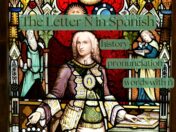Simple R vs Rolled R in Spanish: A Pronunciation Guide

Get our free email course, Shortcut to Conversational.
Have conversations faster, understand people when they speak fast, and other tested tips to learn faster.
More infoLearning Spanish can be an exciting journey, especially when it comes to mastering its unique sounds. One of the most challenging aspects for English speakers is the pronunciation of the Spanish R. Is there a simple R sound, or do you always need to roll your Rs?
This guide will help you understand these different R sounds in Spanish and their significance in the language, including tips on how to roll your Rs in Spanish like a native speaker.
Let’s get to it!
Simple R in Spanish
The simple R sound is known formally as an alveolar tap in English, and as un vibrante simple in Spanish. Informally, Spanish speakers usually just call it ere. This soft R sound is similar to how Americans pronounce the “tt” in words like “butter” when said quickly.
This Spanish R sound is often represented by a single R placed between two vowels, at the end of a word, or immediately following a consonant other than l, n, or s.
- Caro – Expensive
- Pero – But
- Amor – Love
- Dolor – Pain
- Fruta – Fruit
- Problema – Problem
To pronounce the simple r in Spanish you have to position the tip of your tongue just behind your upper front teeth, lightly touching the alveolar ridge (the bumpy area behind your teeth), then flick your tongue against the alveolar ridge, similar to how you would produce a soft /d/ or /t/ sound in English. The movement should be brief and light.
Rolled R in Spanish
The Spanish rolled R is actually known as a trill in English, or as un vibrante múltiple in Spanish. It’s also simply known as erre in Spanish. This rolling R sound in Spanish is produced when the tip of the tongue vibrates rapidly against the roof of the mouth.
This sound can be found in words with both a single R and a double RR in Spanish. The double RR is found between two vowels, while the single R pronounced with a trill is at the beginning of the word, or immediately after the consonants l, n, or s. Try pronouncing these rolling R words in Spanish:
- Carro – Car
- Perro – Dog
- Ramo – Bouquet
- Reno – Reindeer
- Enredado – Tangled
- Alrededor – Around
So how do you roll your Rs in Spanish? This sound is considered tricky, so do your best to follow these tips.
First, place the tip of your tongue lightly against the roof of your mouth, right behind your upper front teeth. This is where the vibration needs to happen. Begin by repeating the /d/ or /t/ sound, which places your tongue in the correct position. Gradually, try to make the sound lighter and quicker, aiming for a soft tap. Exhaling lightly through the throat at the same time can give the tongue some bounce, launching your rolling Rs. Put this into practice every day and you’ll soon be rolling your Rs in Spanish without even thinking about it!
R vs RR in Spanish
As you’ve probably noticed, some Spanish words only differ in spelling by a single R or double RR. These are very different words, and pronouncing them without differentiating between the simple R or rolled R will change their meaning entirely! Here are a few examples of r words vs rr words in Spanish:
- Pero vs Perro – But vs Dog
- Moro vs Morro – Moor vs Snout
- Caro vs Carro – Expensive vs Car
Mispronouncing these words gives them very different meanings, which is why it’s essential to get the sounds right.
Conclusion: R in Spanish
Well done! Mastering the pronunciation of R and RR in Spanish is an important step in your language-learning journey. Not only does it help you communicate more effectively, but it also adds to your confidence and fluency in Spanish. Let’s do a quick wrap-up before saying goodbye!
We learned that there are two distinct R sounds in Spanish: the simple R and the rolled R. Both these sounds are specific to certain contexts, and the pronunciation of one or the other can completely change the meaning of a word.
We also acknowledged that the rolled R in Spanish can be challenging for some learners, so we reviewed some tips to get it right. For more practice, read our full lesson on pronouncing all the letters of the Spanish alphabet or check out our post with over 100 Spanish words that start with R. If you’re up for a challenge you can even try our tongue twister post with some of the most difficult words to pronounce in Spanish, including tough R words like ronronear and ferrocarril.
Remember that the key to success is consistent practice and patience. Use the tips and techniques provided in this guide, and don’t be discouraged if it takes time. With dedication, you’ll be rolling your Spanish Rs like a native speaker before you know it. ¡Buena suerte!



